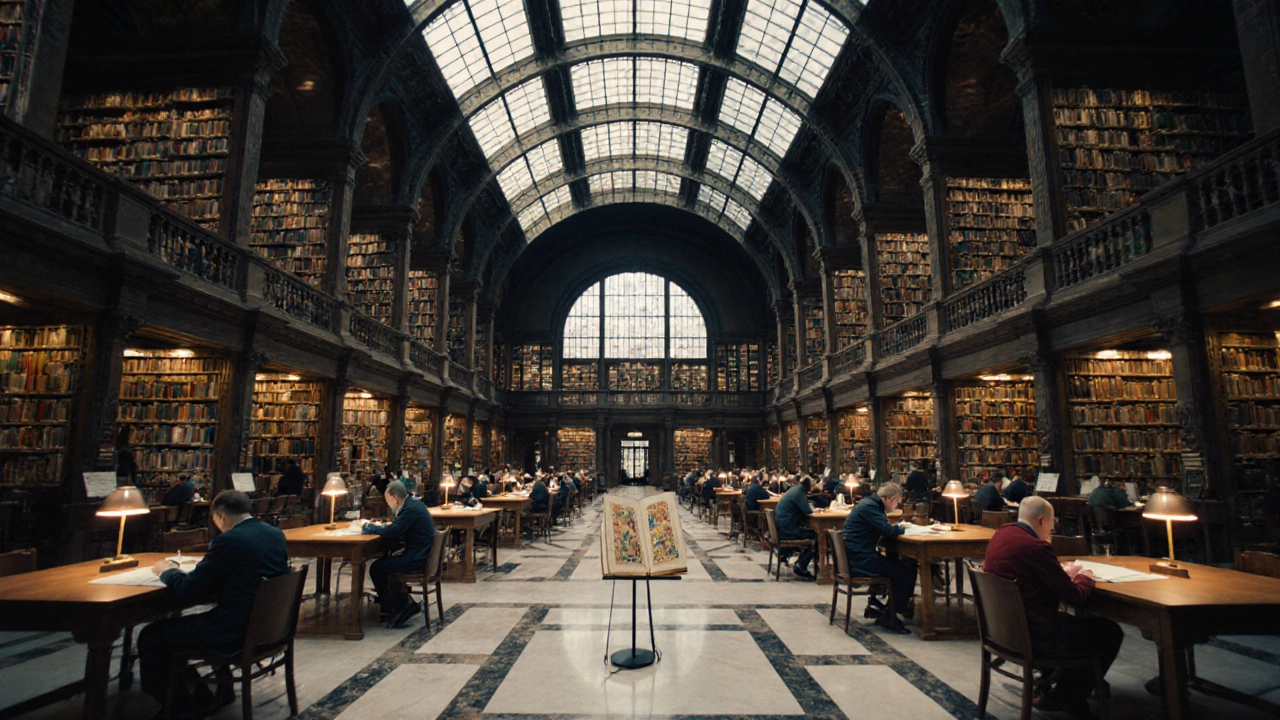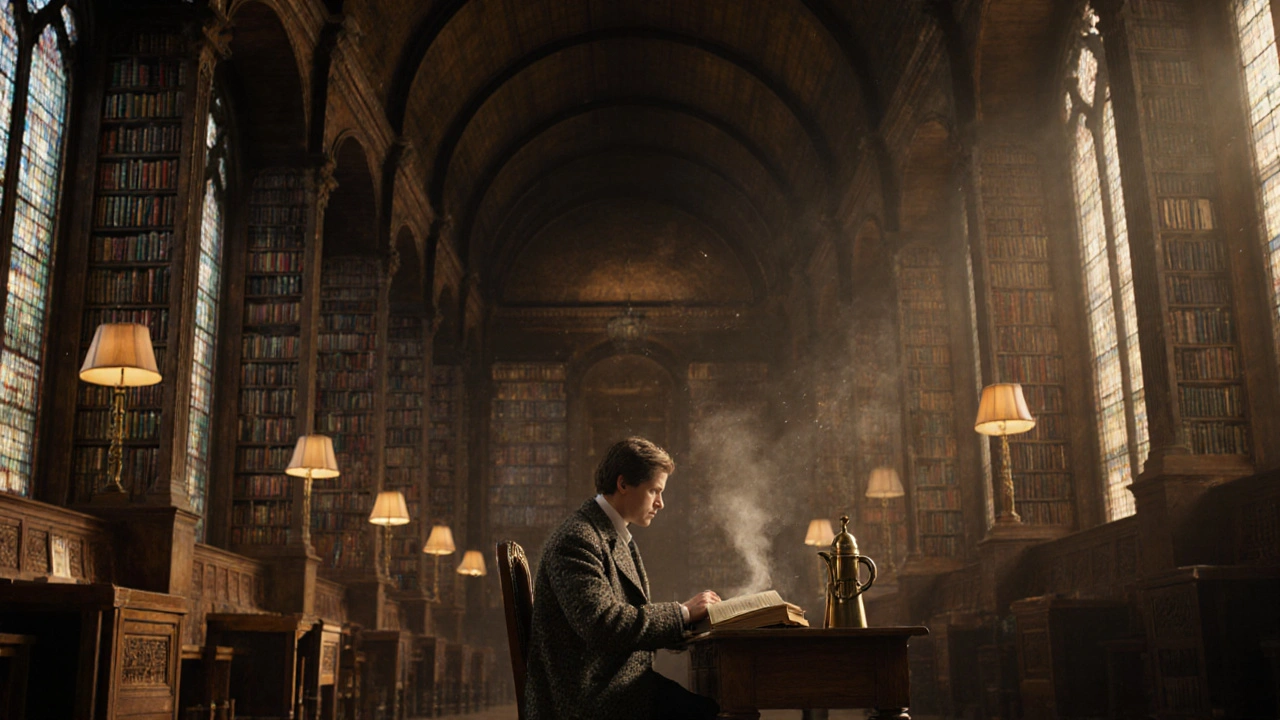London isn’t just about the Tube, the Thames, or the changing of the guard. For readers, it’s a city of quiet corners, towering shelves, and centuries of stories tucked away behind heavy doors. If you’ve ever wanted to sit in a room where Dickens might have once flipped through pages, or where Virginia Woolf once found her rhythm, London’s libraries deliver that kind of magic-without the crowds.
The London Library: Where Books Still Rule
The London Library, founded in 1841, isn’t just a library-it’s a sanctuary. Located in St James’s Square, it’s one of the last great independent lending libraries in the world. You won’t find self-checkout kiosks here. Instead, you’ll find librarians who know where every book lives, and members who treat the stacks like sacred ground.
Its collection? Over one million volumes. That’s not just fiction and poetry-it’s rare first editions, out-of-print academic texts, and niche journals you won’t find anywhere else. The reading rooms are quiet, lit by natural light, and lined with oak bookshelves that stretch up to the ceiling. You can sit there for hours, sipping tea from your own thermos, and feel like you’ve stepped into a Victorian novel.
Membership costs £395 a year, but if you’re serious about reading, it’s worth it. You can borrow up to 20 books at a time, and they’ll even deliver them to your door. Members include Zadie Smith, Salman Rushdie, and the late John le Carré. This isn’t a place for casual browsing. It’s for those who treat reading like a daily ritual.
British Library: The National Archive of Thought
If the London Library feels like a private club for intellectuals, the British Library is the grand cathedral of knowledge. Open to everyone, no membership needed, it’s the largest national library in the world by volume-over 170 million items, including manuscripts, maps, sound recordings, and even the original draft of Harry Potter and the Philosopher’s Stone.
The Reading Rooms here are silent, almost sacred. You’ll need a Reader Pass to access the collections, but getting one is simple: bring ID and proof of address. Once inside, you can request anything from a 12th-century gospel to a 1980s punk zine. The staff are experts-not just librarians, but historians and archivists who can help you track down obscure references.
It’s not just for academics. I’ve seen students writing novels, retirees researching family history, and tourists reading Shakespeare in the original First Folio. The building itself is a marvel: modern glass and steel, but with a reading room that feels like a cathedral. The view from the top floor, overlooking Euston Road, is one of the most peaceful in central London.
Westminster Reference Library: The Hidden Gem
Most tourists never make it here, but locals know Westminster Reference Library is one of the best free public libraries in the city. Tucked away near Victoria Station, it’s spacious, well-lit, and surprisingly quiet-even during lunchtime.
What makes it special? The local history collection. If you’re tracing your ancestors who lived in Westminster, or researching the history of the Houses of Parliament, this is your spot. They have digitized census records, old newspapers on microfilm, and even postcards from the 1920s. The staff are patient and helpful-they’ll spend 20 minutes helping you find a single photo from 1912.
It’s also one of the few libraries in London with a dedicated children’s section that doesn’t feel like a toy store. There are comfy armchairs, no loud music, and a quiet corner for teens doing homework. If you want to read without paying a penny, this is one of the best places in central London to do it.

Islington Central Library: A Modern Reading Oasis
Islington’s library, redesigned in 2019, proves that public libraries aren’t relics-they’re evolving. The building is bright, airy, and full of natural light. There’s a café inside, with real coffee and decent pastries. You can borrow books, watch films, attend poetry readings, or just sit by the window with a novel.
What sets it apart? The community focus. They host weekly writing workshops, book clubs for refugees, and monthly author talks with indie publishers. Last year, a local poet held a reading here that drew over 150 people. The staff don’t just manage books-they build connections.
It’s also one of the few libraries in London that lets you reserve a private study room for free. If you need to write, edit, or just escape the noise of home, you can book a two-hour slot online. No membership required. Just walk in, show your ID, and you’re in.
Barbican Library: For the Curious and the Creative
Nestled inside the Barbican Centre, this library feels like a secret. It’s not big, but it’s perfectly curated. The focus? Art, design, architecture, music, and film. If you’re into graphic novels, avant-garde cinema, or experimental theatre, this is your library.
The shelves are arranged by theme, not Dewey Decimal. You’ll find books on Japanese woodblock prints next to books on punk album covers. There’s a whole section on London’s underground music scene from 1977-1985. The staff here are curators-they’ll recommend you a book you didn’t know you needed.
It’s open to the public, and you can sit in the reading area overlooking the water garden. The silence here is different-it’s the quiet of deep focus, not the quiet of boredom. You’ll leave with more than a book. You’ll leave with a new perspective.

What Makes a Great Library in London?
Not all libraries are the same. Some are about access. Some are about silence. Others are about community. The best ones in London do all three.
Here’s what separates the great ones:
- Staff who know their collections-not just where the books are, but why they matter.
- Spaces designed for focus-no blaring speakers, no coffee shop chaos, just quiet and light.
- Access without barriers-no membership fees for the public ones, easy sign-up for the rest.
- Unique collections-whether it’s a 17th-century playbill or a 1990s fanzine, the best libraries have things you can’t Google.
And here’s what to avoid: libraries that feel like warehouses. If you walk in and see a lone librarian staring at a screen, surrounded by dusty shelves, walk out. London’s best libraries aren’t just storage-they’re living spaces for readers.
How to Choose the Right One for You
Ask yourself:
- Do you want to borrow books? Go to the London Library or your local branch.
- Do you want to read rare manuscripts? Head to the British Library.
- Do you want to write, study, or work in peace? Try Islington or Westminster.
- Do you want to discover something unexpected? Barbican is your place.
- Do you want to meet other readers? Check the events calendar at Islington or the Southbank Centre Library.
You don’t need to pick just one. Many readers rotate between them-London Library for deep dives, Westminster for local history, Islington for coffee and quiet.
Final Thought: Libraries Are the Quiet Heart of London
In a city that never sleeps, libraries are the places where time slows down. You won’t find influencers here. No one’s taking selfies with the books. Just readers. Writers. Thinkers. People who still believe that words matter.
There’s something powerful about walking into a library and knowing you can access centuries of human thought-for free. Whether you’re here for a novel, a thesis, or just a moment of calm, London’s libraries don’t just hold books. They hold space for you.
Do I need a membership to use London libraries?
It depends. The British Library, Westminster Reference Library, Islington Central Library, and Barbican Library are all free to use-just show ID. The London Library requires a paid membership (£395/year), but it’s one of the few places where you can borrow books for home. Most local libraries across London offer free membership to residents.
Can I bring my laptop to London libraries?
Yes, absolutely. All the major libraries encourage laptop use. The British Library has power outlets at every seat. Islington and Barbican have dedicated quiet zones for digital work. Just be respectful-no loud calls or videos.
Are London libraries open on weekends?
Most public libraries are open Saturday and Sunday, but hours vary. Islington and Westminster are open weekends. The British Library is open daily, including Sundays. The London Library is open Monday-Saturday. Always check their websites before visiting.
Can I access digital books through London libraries?
Yes. All public libraries in London offer free access to Libby and BorrowBox for e-books and audiobooks. The British Library has a digital archive you can access with a Reader Pass. The London Library offers digital catalog access to members, with some e-books available for download.
What’s the best time to visit London libraries?
Weekday mornings-especially Tuesday to Thursday-are the quietest. Avoid lunchtime (12:30-2:00 PM) and Friday afternoons, when students and tourists crowd in. The British Library’s Reading Rooms are often empty before 10 AM on weekdays.
Are there any free reading events in London libraries?
Yes. Islington hosts weekly poetry nights. The British Library runs free author talks and literary exhibitions. Westminster offers history workshops. Barbican has film screenings with book discussions. All are free and open to the public-check their event calendars online.
If you’re looking for more places to read in London, try the Southbank Centre Library-it’s small, stunning, and right by the river. Or visit the St Pancras Library, which has a beautiful reading room with stained glass windows. But start with these six. They’re the ones that truly understand what a library should be.
